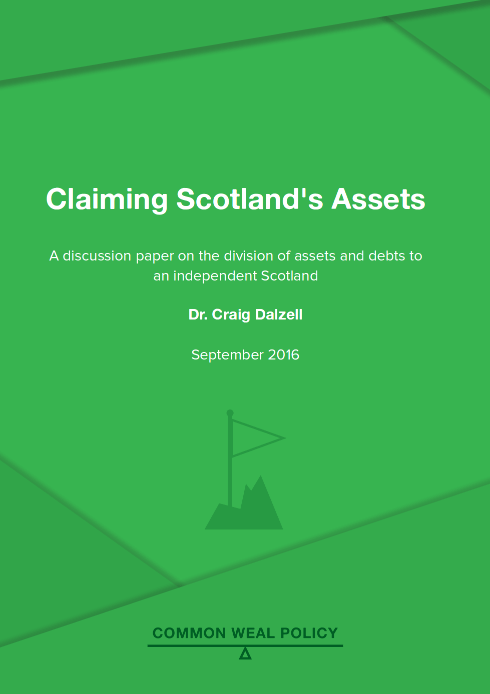One should have three major principles. Talk, boldness and strategy. – Fujibayashi Yasutake
Today sees the launch of my latest paper for Common Weal, Claiming Scotland’s Assets, in which we discuss the consequences of independence with regard to debt and asset negotiations.
 (click image for full report)
(click image for full report)
During the 2014 independence campaign, what talk their was about debt and asset negotiation circled basically around two options:
a) Scotland takes a full population of assets and debts.
b) Scotland takes and gets nothing (with no discussion of the further consequences of that).
Examining the historical precedents of state separation reveals that whilst no previous example of independence provides exact parallels to Scotland’s case, there will be far more nuanced options ahead of us and that no matter which one we end up with, Scotland will be in a far better position financially because of it with savings to be had amounting to between £800 million and £2 billion per year.
Key Points:-
• The manner in which states separate is crucial for determining asset division. In particular, the rUK’s likely desire to maintain “successor” or “continuing” status to the former UK will likely be largely determined by its willingness to guarantee the debts of the former state.
• The assumption that the baseline for division should be on population can and should be challenged. Many state separations have negotiated settlements which place weight on territoriality as well as the historical contributions and beneficiaries of the former unions. It may be that Scotland has been a historical net contributor to the UK thus may have already more than paid its “share” of the national debt.
• The previous independence campaign discussed the possibility of a subtractive model of asset separation whereby the value of any assets withheld from Scotland by rUK (for example, currency and foreign reserves) would be subtracted from debt liabilities accepted. This report suggests instead an additive model whereby Scotland begins with the assumption of accepting no debt but will accept debt up to the value of assets transferred. It may be that Scotland actually requires less from this transfer than the subtractive model would suggest.
• For the additive model to be actionable, an up-to-date register of assets will be essential. With the last UK Government register of assets in 2007, the Scottish Government must press the UK Government to commission a new register or conduct a Scottish audit in the near future.
• Additionally, the prospect of Scotland issuing its own bonds and buying what is required is explored (‘the zero option’). This model may have significant advantages with regard to being able to denote the debt in Scotland’s own independent currency thus maintaining full control over debt management and significantly reducing the chances of a default.
• The precedents and models outlined would likely all accrue varying levels of financial benefit to Scotland if utilised properly. A lack of up to date data makes precise figures impossible, but a conservative illustration of each model in the Scottish context would suggest a £800m per year financial gain from the subtractive model with refinancing; a £1.7 billion reduction in debt interest payments from the additive model without refinancing; a saving of over £2 billion per year from the zero option; and, in the case of historical net contribution, a possible financial contribution from rUK to Scotland.
Regular readers will know now that Common Weal has been very hard at work looking at the issues surrounding the independence debate, especially those arguments which just simply didn’t convince a certain segment of voters. I think we were all hoping that ‘someone else’ would come along and do this right after the last referendum but, for various reasons, it hasn’t happened. So Common Weal has decided to just roll up our collective sleeves and do it.
We’ve already published a paper reopening the currency debate, and now another on debt. We want to produce further papers on pensions, defence, customs and excise, a detailed paper on the role of the Central Bank of Scotland, and others. All working up to a paper not just showing the limitations of accounting exercises like GERS but doing away with it entirely and building a case for an independent Scottish budget built from the ground up to suit our needs, rather than just being a tweaked version of what the UK does.
We are incredibly under resourced for this work but we think it’s work worth doing.


Pingback: Claiming Scotland’s Assets — The Common Green – fionamoragrahame
Pingback: IT’S HOW BIG? | Young Team For Independence
I thought that was a very interesting and thought provoking report and I applaud the level of detail that has gone into it.
I had a question / mild challenge around the view that Scotland would be able to borrow more cheaply than the UK – (whilst I take the point about historical yields being higher than they are now) – during the run up to the 2014 referendum, Moody’s indicated that an ‘A’ rating (i.e. somewhere between A1 and A3) would be the most likely initial rating that Scotland would achieve (https://www.moodys.com/research/Moodys-Scottish-independence-unlikely-to-have-rating-implications-for-UK–PR_298421).
Moody’s also noted that this could be (negatively) impacted by Scotland’s negotiating stance (the ‘A’ assumes a proportionate share of debt).
Given that the UK borrows at an AA1 level (which is two tiers higher) – this would imply that Scotland would struggle to lower borrowing costs initially.
So – I’d be curious to know what your views are on Scotland’s initial credit rating etc.
Thanks
LikeLike
My estimate rather axiomatically assumes that Scotland would have a more expensive instantaneous borrowing rate than rUK but that savings would be realised due to not having the burden of more expensive historical debt. It’s a subtle point to get one’s head around but I hope it does come through.
On actual credit rating, I think we need to stop fixating on the actual grade.
Whilst bond yield DOES tend to increase with decreasing credit rating, there is a spread of yields between countries of similar credit ratings which is determined by other factors such as tax rates, soundness of economy, balance of trade and all manner of things. As it turns out, the effect of decreasing bond yield only starts to outweigh these other factors once a country drops into “junk” territory.
(Feel free to correlate data from:
http://www.tradingeconomics.com/country-list/rating
and
http://www.tradingeconomics.com/bonds)
The UK didn’t see bond yields spike up when it lost credit grades recently (in fact, the underlying downward trend continued) and this pattern has been seen in other countries. I don’t think Scotland’s actual credit rating will be particularly indicative of our borrowing costs.
LikeLike
Thanks!
The historical point does come across.
I would have thought that credit ratings were quite correlated to the ‘other factors’ you list. I’d hope Moody’s made some sort of assessment of how sound an economy is before giving it a rating. I will have a look at the data you pointed me to though and see if that is the case.
The point about the UK – yes. Major investors in bonds make their own decisions (and merchant banks have their own credit rating departments) – so a rating downgrade may not always show up in yields. I think markets may actually price these things in long before the rating agency gets round to it.
However I don’t really know how this works with a new country – where there is less available data. I could see, in that circumstance, the opinions of rating agencies hold more weight – simply because there wouldn’t be much else to go on.
Of course, it is all dependent on how negotiations would go and who the government were etc etc. On the assumption that the first government of an independent Scotland was an SNP administration, then hopefully they would have supplied a sufficiently detailed economic plan prior to independence that investors could have something to judge for themselves.
LikeLike
Pingback: Scott Arthur’s Panto | Young Team For Independence
Pingback: Brexit Means…? | The Common Green
Pingback: Beyond GERS | The Common Green
Pingback: Beyond GERS:- A Response to Comments | The Common Green
Pingback: The Common Green’s 2016 Retrospective | The Common Green
Pingback: The White Paper Project | The Common Green
Pingback: Eskozia independentea eta moneta propioa | Heterodoxia, diru teoria modernoa eta finantza ingeniaritza
Pingback: QuEUing up for Membership | The Common Green
Pingback: The Confidence Trick | The Common Green
Pingback: Affording It | The Common Green
Pingback: Affording It -